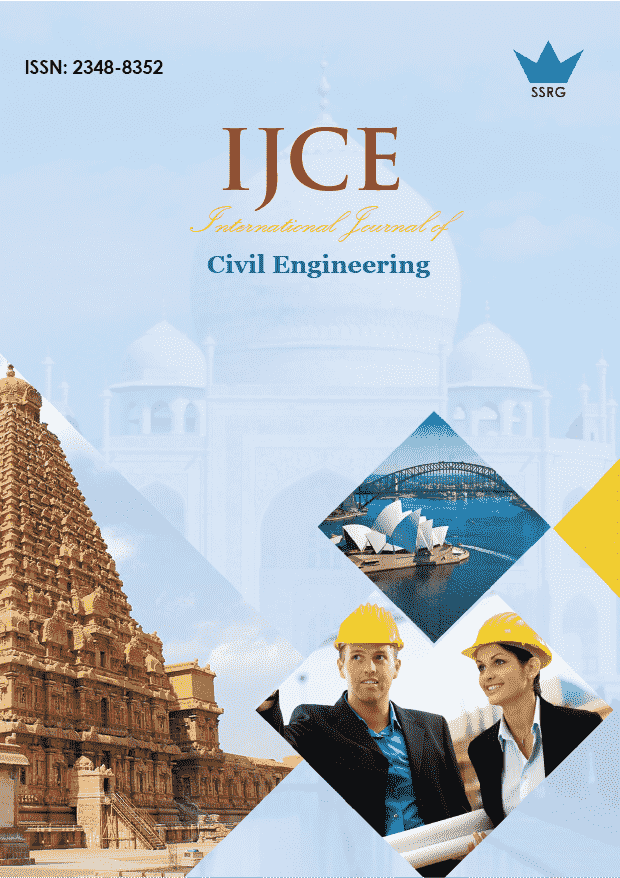Application of the mixed hybrid Finite element approximation to Water transfers in variably Saturated porous media with timevarying Infiltration

| International Journal of Civil Engineering |
| © 2015 by SSRG - IJCE Journal |
| Volume 2 Issue 1 |
| Year of Publication : 2015 |
| Authors : El Hadji Bamba Diaw, Moustapha Ndiaye, Fala Paye, Mamadou Lamine Diallo, Séni Tamba, Ajay Manglik, Grégoire SISSOKO |
How to Cite?
El Hadji Bamba Diaw, Moustapha Ndiaye, Fala Paye, Mamadou Lamine Diallo, Séni Tamba, Ajay Manglik, Grégoire SISSOKO, "Application of the mixed hybrid Finite element approximation to Water transfers in variably Saturated porous media with timevarying Infiltration," SSRG International Journal of Civil Engineering, vol. 2, no. 1, pp. 1-10, 2015. Crossref, https://doi.org/10.14445/23488352/IJCE-V2I1P101
Abstract:
In this study, a two-dimensional model for simulating water in homogeneous-heterogeneous, saturatedunsaturated porous media is presented. The model is based on the mixed-hybrid finite element method and the h-based form of the Richards equation is solved [16]. The time-varying infiltration is approximated by a number of piecewise linear elements of different lengths and slopes depending on the nature of the variation in infiltration rate. The unsaturated flow model (MHNS_2D) is applied to a variety of rigorous problem including transient flow in dry conditions and time-varying boundary conditions. It produces accurate predicted suction distribution in dry conditions compare to the analytical solution of J.R. Philip. It is also shown to provide good global water mass balance accuracy in simulations of vertical infiltration in spite of solving the h-based form of the Richards equation. MHNS_2D is used also to predict the water table fluctuation of an unconfined aquifer in response to time varying infiltration
Keywords:
unsaturated porous media; numerical model; mixed-hybrid finite element; time-varying infiltration
References:
[1] Allen, M.B. and Murphy, C. L., 1986. A finite element collocation method for variable saturated flow on two space dimension. Water Resources Res. 22, 1537 – 1542.
[2] Celia M. A., E. T. Bouloutas, and R. L. Zarba, 1990: A general mass-conservative numerical solution for the unsaturated flow aquation, water Resour. Res., 26(7), pp. 1483 – 1496.
[3] Chavent G. and J. Roberts., 1991: A unified physical presentation of mixed, mixed-hybrid finite elements and standard finite difference
approximation for the determination of velocities in waterflow problems. Adv. Water Resour., 14(6): pp.329-348.
[4] Dierch, H. ̶J. G. and Perrochet, P., 1999. On the primery variable switching technique for simulating unsaturated-saturated flows. Advances in water Resources, 23, 271-301.
[5] Haverkamp, R., Vauclin, M., Touma, J.? Wierenga, P.J. and Vachaud, G., 1977. A comparison of numerical simulation models for one-dimension, Soil Sci. Soc. Am. J., 41,285-294.
[6] Huyakorn, P. S., and G. F. Pinder, 1983: Computational Methods in Subsurface Flow, Academic, San Diego, Calif.
[7] Kinzelbakh W., 1986. Groundwater modeling. An introduction with sample programs in BASIC. Developments in Water Sciences. Elsevier, Amsterdam, 333p.
[8] Lehman, F., Ackerer, Ph., 1998. Comparaison of iterative methods for improved solution of the fluid flow equation in partially saturated porous media. Transp. Porous Media 31 (3), 275-292.
[9] Mangelik A. and S. N. RAI, 2000: Modeling of water table fluctuation in response to time-varying Recharge and withdrawal. Water Resources Management, 14: 339-3347.
[10] Mose R., Siege P., Ackerer Ph., and G., 1994. Application of the mixed hybrid finite element approximation in a ground water flow model: luxury or necessity? Water Resources Res. 30(11): 3001.
[11] Mualem Y., 1976: A new model for predicting the hydraulic conductivity of unsaturated porous media. Water Resour. Res., 12: pp. 5135-522.
[12] Philip J. R., 1969: Theory of infiltration, in Advences in Hydroscience, edited by V. T. Chow, vol 5, pp. 215-305, Academic, san Diego, Calif.
[13] RAI S. N. and A. Mangelik, 2000. Water table variation due to time-varying recharge with withdrawal. Groundwater: Past Achievements and Futures Challenges, Sillio et al. (eds) pp. 259-262.
[14] Rathfelder K. and L. M. Abriola, 1994: Mass conservative numerical solution of the h-based Richards equation, Water Resour. Res., 30(7), pp. 2579-2586.
[15] Raviart P. A. and Thomas J. M., 1977: A mixed finite method for the second order elliptic problems, Mathematical aspect of the finite element method, Lecture notes un Mathematics, Spring Verlag, New York.
[16] Richards L. A., 1931: Capillary conduction of liquids in porous media, Physics 1, pp. 318-333.
[17] Russo D., 1988: Determination of soil hydraulic properties by parameter estimation: on the selection of a model for the hydraulic properties. Water Resour. Res., 24 (3) pp. 453-459.
[18] Simunek J., Vogel T. and M. Th Van Genuchten, 1992: The SWMS _2D Code for simulating Water flow and solute Transport in Two –Dimensional variably saturated media. US Salinity Lab., Riverside, CA. Research report n 126, 169p.
[19] Thomas J. M., 1977: Sur l’analyse numérique des méthodes d’éléments finis hybrides et mixtes. Thèse de Doctorat d’état, Université Pierre et Marie Curie.
[20] Van Genuchten, M. Th., 1982. A comparison of numerical solution of the one-dimensional unsaturated-saturated flow and mass transport equation. Advances in Water Resources. 5, 47-55.
[21] Van Genuchten M. Th., 1980: A closed form equation for Soc. Am. J., 44, pp. 892-898.

 10.14445/23488352/IJCE-V2I1P101
10.14445/23488352/IJCE-V2I1P101